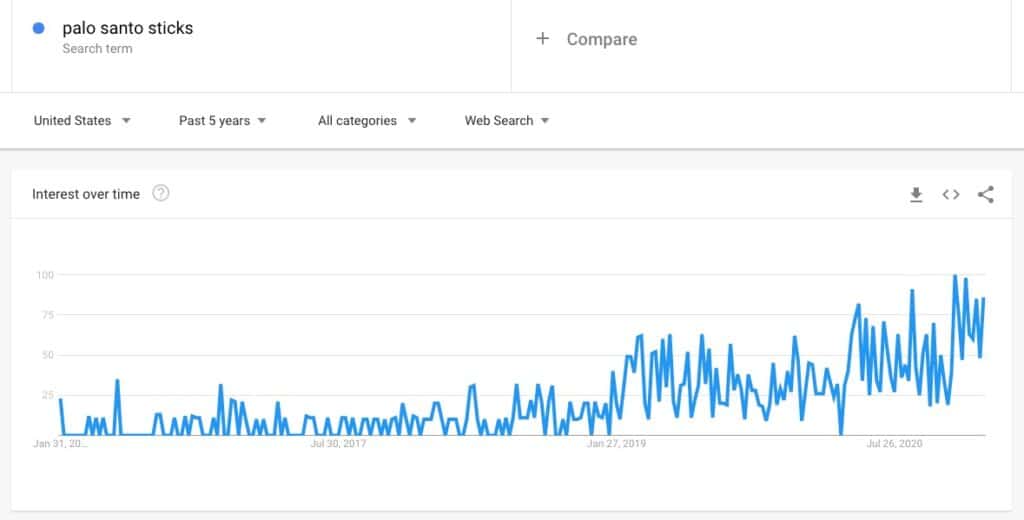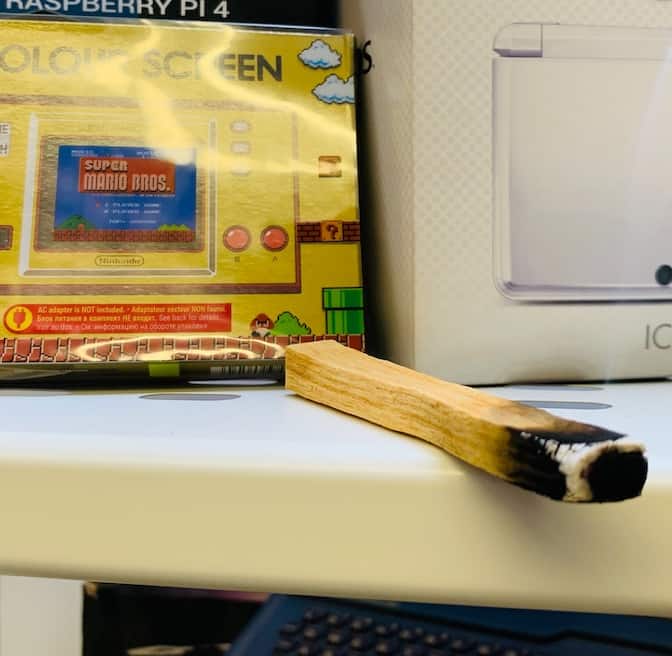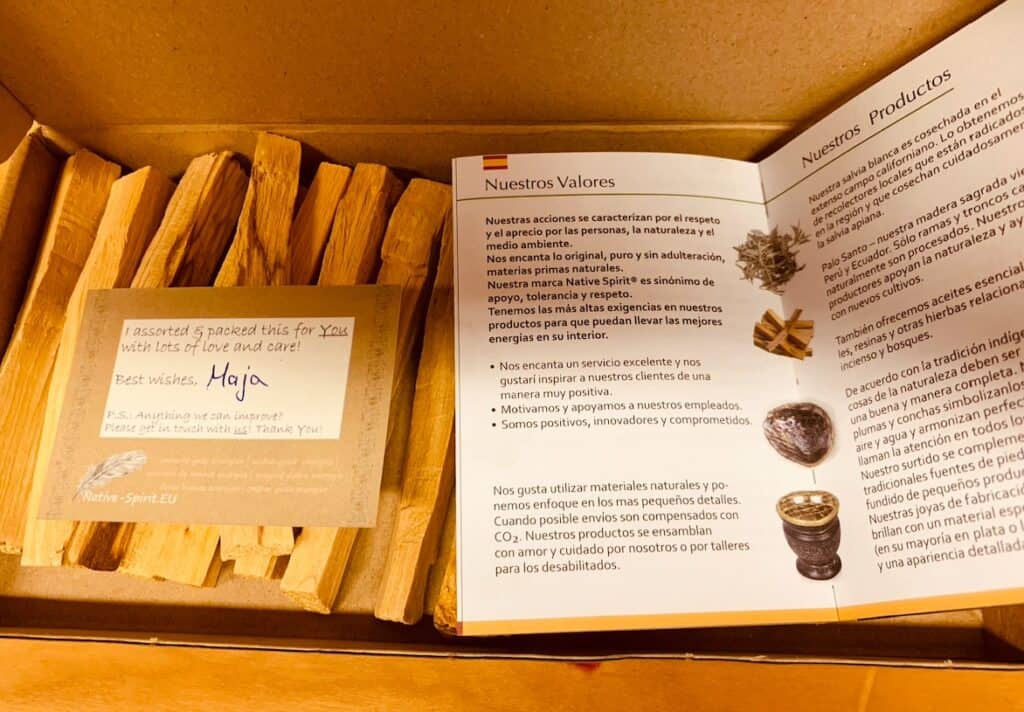Based on the hype around Palo Santo sticks these days, you’d be forgiven for thinking they are a miracle cure for all ills.
Palo Santo wood is claimed to clear up all kinds of problems, from sinus congestion to anxiety and depression. Some people even believe it can deliver good fortune and healing, and rid your home and body of negative energy.
Wow! What’s not to like? Burn some special wood, get rid of stress, and shake off all those irritating health issues!
I am, of course, being intentionally flippant and sceptical. Because as with many natural and traditional remedies, a research session doesn’t bring you many results of clinical trials. Instead you get lots of “Palo Santo might…” and “Palo Santo is believed to….”
In this article, I take a deep dive into Palo Santo wood, and discuss whether the benefits of Palo Santo are fact or fiction. I’ve used the sticks for a while now, and feel I can help you to decide whether to invest in some yourself.
A Little Background: Why a Strong Scent Could Help You Right Now
I’ve going to start with the absolute basics in a moment, but first a quick bit of background.

I hadn’t heard of Palo Santo wood until last year, when suddenly I encountered it twice in as many weeks. The first time was when I was having a brief staycation, and I noticed a mysterious semi-burned stick in a dish in my Airbnb bathroom.
Shortly afterwards I was watching a live-streamed DJ set from one of my favourite DJs, Natasha Diggs (if you like soul and funk music you MUST check her out!) During her set, I saw her wafting a burning stick around the DJ booth. Somebody in the comments mentioned that it was Palo Santo incense.
In a strange show of serendipity, I also read an article around that time from a scientist, discussing how lockdowns and social distancing measures were leaving many of us in a state of sensory deprivation.
If you think about it, it makes perfect sense. I’m barely going anywhere – and not visiting my local cities, let alone the unfamiliar ones I try to explore every year. In (quite literally) every sense, there’s less stimulation going into our brains in these unusual times.
The article I read suggested exposing yourself to stronger aromas than usual – things like incense sticks and essential oils. (Read my VictSing Diffuser review for more on the latter). The idea being that it can help to compensate for that depravation.
I was sold. There was both a scientist and a very cool DJ advocating the use of these aromatic products. I put some Palo Santo wood sticks on my Christmas list.
It turns out that I’m not the only person taking a new interest in wood from the Palo Santo tree. The graph below shows how more and more people search for it on Google these days.

What is Palo Santo Wood?
Palo Santo Wood is wood from the bursera graveolens tree, a tree native to various countries in South America, particularly Ecuador and Peru. Palo Santo is known as “Holy Wood,” which is also the literal Spanish translation.
Palo Santo incense, wood and essential oil have all been used medically and spiritually for hundreds of years. Palo Santo is used for many purposes, from scenting sacred shamanic rituals to naturally repelling mosquitos.
Use of this “holy wood” is a popular solution to many problems among both indigenous South Americans and those from elsewhere seeking natural wellness options. However, it’s important to understand that reports of its effectiveness are almost entirely anecdotal.
What are Palo Santo Sticks?
Palo Santo sticks are small sticks of wood from the Palo Santo tree (the bursera graveolens). The sticks have a high resin content and produce a strong scent during burning.
Sometimes referred to as “smudge sticks,” many people use these products to ease stress, relieve ailments, and encourage good energy into their environment. (Sage smudge sticks are also available, but unrelated to Palo Santo).
The Benefits of Palo Santo Wood
The alleged benefits of Palo Santo are numerous. Here are some of the main things that people believe burning Palo Santo can help with. Below, I also discuss whether the product has helped ME with any of those issues.
Relief from Depression / Stress / Anxiety
Palo Santo is reputed to have numerous positive effects on mental health, from relieving anxiety to reducing the negative emotions that contribute to depression.
Relaxation
On a similar note, Palo Santo incense is thought to aid in relaxation. It’s often used by message and reiki practitioners for this reason.
Help with Sinus and Breathing Issues
Palo Santo is said to help with sinus issues such as pressure and congestion, and to improve breathing. Obviously it’s important to emphasise that this benefit should come from inhaling the scent, rather than the burning smoke.
Pain and Inflammation Relief
Some believe that Palo Santo reduces inflammation and pain, including headaches, arthritis and throat issues.
Reduction of Negative Energy
One of the more spiritual uses for Palo Santo products is to promote a cleansing reduction of negative energy. Many people burn Palo Santo wood and waft the smoke around the corners of rooms or around the body, a process known as smudging. This is often a fundamental part of traditional cleansing rituals.
An Insect Repellent
Aside from the Palo Santo benefits related to health, the product is also well-known as an effective insect repellent. It’s often used in Ecuador and elsewhere to deter mosquitoes and other bugs.
How Does Palo Santo Work?
Exactly how Palo Santo wood works is unclear, with many of the benefits of the bursera graveolens tree being theoretical, rather than based on science. However, one aspect that has some factual evidence behind it is the presence of limonene, a strong, lemon-scented terpene present in many natural products.
Some studies into limonene have shown the substance to reduce stress and anxiety. Furthermore, there’s also evidence to suggest that it can have an anti-inflammatory and pain relieving effect.
Although there’s limited evidence into exactly HOW Palo Santo sticks work, there IS at least some solid basis to believe that the limonene plays a part in how and why it lives up to its claims.
My Own Experiences with Palo Santo

I should begin this section by saying that I’ve approached my own use of Palo Santo with a mixture of hope and scepticism. I also wanted to try it out from at least a slightly scientific perspective, to determine the answer to the big question:
Does Palo Santo ACTUALLY WORK?
Like many people living through the chaos of 2021, I certainly have my fair share of stress, and a keenness to try anything with natural healing properties. But I didn’t expect miracles as a result of “smudging” a burning stick around my home!
And I didn’t experience any miracles. However, my own results have been good – better, in fact, than expected.
When it comes to all of the things that this “holy wood” is claimed to do, I’m certainly a qualifying beneficiary. I have anxiety, sinus problems and regular headaches. At the time of writing this, it’s January 2021 and I’m confined to my home in the UK due to lockdown. I usually escape the country to somewhere warmer and sunnier at this time of year, so I’m holding seasonal depression at arms length right now too.
After unwrapping my little parcel of Palo Santo sticks, I looked online to find out how to use them, and did a few experiments.
Experiment 1: Relaxation
To begin with, I decided to see how Palo Santo could help with relaxation, and thought I’d try out the first stick whilst lying in the bath.
I let the wood burn in a lighter flame for 30 seconds or so, then wafted the smoke around the corners of the bathroom as instructed. I also had a tentative go at “smudging” around my body (something I’m awfully glad nobody had to witness me do!)
The smell was surprisingly intense, rather like church incense. Despite the limonene, lemon didn’t seem to be the main scent. It did seem to have a heady eucalyptus edge. The (very agreeable) smell left behind in the room a couple of hours later does have a lemon aroma.
Obviously a state of relaxation is a hugely subjective thing, but it was certainly a pleasing addition to a hot bath. I’d say it “did” much more, scent wise, than using an essential oil would.
If nothing else, smudging Palo Santo in the bathroom felt like a pleasing act of self-care. I did feel content and positive afterwards, though I obviously cannot confirm that it was entirely down to the healing properties of the product.
Experiment 2: Sinus Pain and Headaches
Using Palo Santo has been rather good for my headaches and sinus pain.
I’ve actually subjected this to a proper test on several occasions now. When my sinus pressure builds to the point where I’d usually take a couple of painkillers, I’ve tried briefly burning a stick in the room first.
To my delight, I’ve found that the aroma almost immediately reduces the pressure – to an extent. This is much the same as if I used a eucalyptus essential oil.
To be clear, it’s not as if Palo Santo is an instant headache cure. BUT, I’d say that the pain relief is enough to prevent me needing to reach for the painkillers 50% of the time. And that’s pretty huge for me.
It was after I’d repeated this experiment a few times that I decided I probably shouldn’t be so cynical about the healing properties of this ancient remedy. After all, something doesn’t keep being used for generations if it doesn’t – at least to some extent – work.
And in my case, it really does for this purpose.

Experiment 3: Depression and Anxiety
My final experiment is, by nature, the most subjective of all.
I’m a firm believer that depression and anxiety are things you live with and control as best you can. You have to be incredibly fortunate to cure them completely.
I’ve used Palo Santo wood on and off for several weeks now – not every day – but I often smudge some of the smoke around before I jump in the shower, or place the stick in the corner of my office for a brief period before I start work.
The best way for me to sum up the results is to say that I’m here typing about Palo Alto wood, rather that cowering in bed or trying to find my way out of a pit of depression.
Given that it’s January, in England, in lockdown, during a pandemic, that’s actually quite a big deal! The thing is, I cannot say whether it’s thanks to the cleansing energy of my Palo Santo sticks, or nothing to do with that at all.
My Own Conclusion
For me, there are enough benefits of Palo Santo for me to continue to use it. I have no idea if it’s bringing me spiritual good fortune or helping to “cleanse the energy” around me – and I don’t much care.
It smells good, it certainly seems to help with headaches, and while the mental health benefits are almost impossible to quantify, it’s certainly done me no harm in that regard. It also lasts for ages, with each Palo Santo stick being good for multiple burns, each of which are sufficient to fill a room with rich aroma.
It certainly does make me reflect on the potential value in these sacred ancient remedies. I doubt that people hundreds of years ago pondered on whether it’s the limonene that makes it work – they were likely just content that it did.
Key Questions
How To Use Palo Santo Sticks
To use a Palo Santo stick, you simply light the end using a match or lighter. Hold the flame to the stick for 20-30 seconds. Blow out the flame, and then waft (smudge) the smoke around the desired areas of the room. Repeat as necessary.
Once the flame is out, you can place the stick in a flame-proof dish. More smoke will continue to appear for a short while. Be sure not to leave it unattended.
How do you Buy Ethical Palo Santo?
Native to Ecuador, Peru, and elsewhere in South America, Palo Santo trees are not endangered. That said, sustainability is important, so it makes sense to check that what you order is ethical and helps out the communities where it’s harvested.
There are many different companies marketing Palo Santo, so be sure to read all the information once you’ve found some. Ensuring you order sustainably sourced Palo Santo isn’t difficult, and Amazon sells many varieties sustainably gathered from trees in Ecuador and Peru.
Does Palo Santo Work?
Anecdotally, Palo Santo works to relieve various conditions, from sinus pressure to anxiety. However, it’s important to note that scientific evidence for its benefits is thin on the ground. The main active component is thought to be limonene, a scented compound found in the resin-rich trees the product comes from.
What Types of Palo Santo Can You Buy?
Palo Santo Sticks – As described in this article, Palo Santo sticks come directly from bursera graveolens trees. You light them with a lighter and use them to scent a room or for smudging rituals.
Incense Sticks – You can find incense sticks with a Palo Santo aroma. To ensure the best effect and smell, ensure you only burn sticks made from authentic ingredients.
Palo Santo Oil – You can buy Palo Santo in essential oil form. Use can generally use the oil directly in a bath, on the skin, or in an oil diffuser – but be sure to read all provided information first.
A Palo Santo Candle -A Palo Santo candle gives you the benefits of this sacred product in candle form, and provides another way to burn Palo Santo.







Wow! Nice comment/information/review of Palo Santo. I bought a stick in a metaphysical magical shop, but it’s way far from where I live, and I don’t think me or my husband will be driving there until next month. We’re in the US so, thank you for the tip on looking at Amazon. I read another article that said Amazon is not truthworthy when buying it, but I can give it a try and compare with the one I have. Thanks again
With Amazon you’ll find dozens of different options, some better than others – generally you can get a sense of what is good quality and ethical / sustainable by having a good look at the description and review. Best wishes,
Ben